![]() Introduction
Introduction
![]() Hiero II
Hiero II
![]() Philistis
Philistis
![]() Gelo II
Gelo II
![]() Hieronymos
Hieronymos
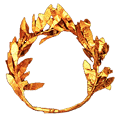
| Back to . . . |
This section . . .
|
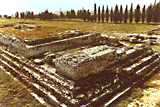 Altar of Hiero 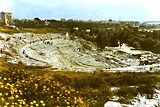 Greek Theater 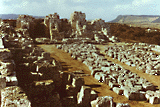 Fort Euryalos  “Hiero of Syracuse Calling upon Archimedes to Fortify the City”. Oil painting by Sebastiano Ricci (1659-1734), housed in the Cecil Higgins Art Gallery (Bedford, UK).  Bronze coin of the Mamertines after they captured Messana about 288 BC. Obverse: Laureled head of Ares/Mars/Mamers with Greek inscription ΑΡΕΟΣ. Reverse: Charging bull with inscription ΜΑΜΕΡΤΙΝΩΝ. 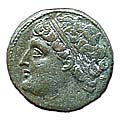
Hiero II Bronze coin  Hiero II Bronze coin 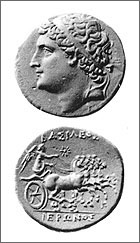 32-litrai silver coin of Hiero II. The reverse depicts a quadriga (a four-horsed chariot) driven by Nike, the goddess of victory. The Greek inscription is ΒΑΣΙΛΕΟΣ ΙΕΡΩΝΟΣ (KING HIERO in the possessive case). |
BIOGRAPHY OF HIERO II
HIERO (or Hieron) was born around 306 BC of unknown lineage. He served as an officer under Pyrrhos, a Greek adventurer who briefly controlled Syracuse c. 278-276 BC. Hiero’s ascent to power began when he was elected co-commander of Syracusan armed forces driven from Syracuse by civil authorities. He executed a military coup of Syracuse about 275 BC after “he used some of his family connections to gain entry to the city,” as Polybius writes. He consolidated his power by marrying Philistis, the daughter of a popular and influential Syracusan named Leptines. When veteran mercenaries who helped him seize power became unruly and disruptive, he led them into a battle in which they were cut to pieces by the enemy after he held back his reserves of Syracusan citizens. In 265 BC Hiero won a decisive victory over the Mamertines, a gang of Italic mercenaries who ran a pirate empire from the Sicilian city of Messana which they had captured. As a result, Hiero was proclaimed King of Syracuse by his grateful subjects. Hiero’s defeat of the Mamertines upset the delicate balance of power among the Greeks, Romans, and Carthaginians, all of whom sought the control of Sicily. Rome’s support of the defeated Mamertines precipitated the First Punic War in 264 BC, in which Carthage and Syracuse were initially allied against Rome. The Romans gained early victories over the Greco-Punic forces and prepared to lay siege to Syracuse. Hiero reconsidered his position and decided that it would be wiser to be an ally of Rome than of Carthage. He negotiated a treaty with Rome in 263 BC under whose terms he agreed to pay tribute and provide supplies and grain to the Romans. Hiero honored this treaty the rest of his life and became a loyal ally of Rome. The treaty guaranteed him a peaceful and prosperous reign as long as the Romans and Carthaginians were occupied in fighting each other. Hiero was an extremely able leader who captured the hearts and minds of his subjects. He rebuilt much of Syracuse during his reign of sixty years. Among his public works still remaining are an enormous sacrificial altar dedicated to Zeus and an enlarged Greek Theater. He also strengthened the defenses of Syracuse, especially Fort Euryalos, under the military guidance of Archimedes. Plutarch describes Archimedes as a near relation of Hiero. He constantly sought Archimedes’ advice on military and other matters. His long reign gave Archimedes the opportunity to peacefully pursue his studies. Hiero and Philistis had one son, Gelo, and two daughters, Damarata and Heraclia. Gelo co-ruled with Hiero for many years and married Nereis, a daughter of Hiero’s old mentor Pyrrhos. Gelo died about a year before Hiero while in his fifties. Hiero died in 215 BC at about the age of ninety and was succeeded by Gelo’s fifteen-year-old son Hieronymos. After Hiero came the deluge. Within three years of his death his grandson Hieronymos was assassinated, his two daughters and other members of his family were put to death by an angry mob, Syracuse was captured and looted by the Romans, and Archimedes was killed by a Roman soldier. Syracuse was reduced to a minor Roman provincial town, ending its illustrious 500-year history as an independent Greek city-state. It never regained its former glory. SOURCES (with links to translation references)
POLYBIUS (Universal History, Book I.8-9) Not long before, the Syracusan armed forces had fallen out with the civil authority. The troops were at that time stationed near Mergane, and they elected two commanders from their own ranks: one of these was Artemidorus and the other Hiero, who later became the ruler of Syracuse [c. 275 BC]. Hiero was still quite a young man, but he was well suited by natural character for some kind of royal position and political authority. Having taken over the command, he used some of his family connections to gain entry to the city. Once inside, he quickly got the upper hand over his opponents, but proceeded to administer affairs with such tolerance and generosity that the Syracusans unanimously acclaimed him as their general, even though they were by no means well-disposed towards leaders chosen by the army. However from the very first measures that he introduced, it immediately became clear to all intelligent observers that his ambitions extended beyond the position of general.PAUSANIAS (Description of Greece, [6.12.2-4]) On Hiero’s rule (Pausanias is describing statues and monuments that he observed at Olympia in the second century AD.): By the chariot of Hiero [Hiero I, who ruled Syracuse 478-466 BC] is a man of the same name as the son of Deinomenes. He too was tyrant of Syracuse, and was called Hiero the son of Hierocles. After the death of Agathocles, a former tyrant [who ruled Syracuse 317-289 BC], tyranny again sprung up at Syracuse in the person of this Hiero, who came to power in the second year of the hundred and twenty-sixth Olympiad [i.e., 275-274 BC], at which Festival Idaeus of Cyrene won the foot-race.PAUSANIAS (Description of Greece, [6.12.2-4]) On Hiero’s rule (Pausanias is describing statues and monuments that he observed at Olympia in the second century AD.): By the chariot of Hiero [Hiero I, who ruled Syracuse 478-466 BC] is a man of the same name as the son of Deinomenes. He too was tyrant of Syracuse, and was called Hiero the son of Hierocles. After the death of Agathocles, a former tyrant [who ruled Syracuse 317-289 BC], tyranny again sprung up at Syracuse in the person of this Hiero, who came to power in the second year of the hundred and twenty-sixth Olympiad [i.e., 275-274 BC], at which Festival Idaeus of Cyrene won the foot-race.LUCIAN (Octogenarians) On Hiero’s longevity: Hiero, tyrant of Syracuse, died of an illness at the age of ninety-two, after having been ruler for seventy years, as Demetrius of Callatia and others say.POLYBIUS (Universal History, Book VIII.7) On Hiero’s defenses of Syracuse designed by Archimedes: This artillery was extraordinarily effective both in the volume of its fire, as was to be expected when Hiero had provided the supplies, and Archimedes designed the various engines.PLUTARCH (Parallel Lives: Marcellus) On Hiero’s defenses of Syracuse designed by Archimedes: These machines he [Archimedes] had designed and contrived, not as matters of any importance, but as mere amusements in geometry; in compliance with King Hiero’s desire and request, some little time before, that he should reduce to practice some part of his admirable speculation in science, and by accommodating the theoretic truth to sensation and ordinary use, bring it more within the appreciation of the people in general.PLUTARCH (Parallel Lives: Marcellus) On Hiero’s defenses of Syracuse designed by Archimedes: Archimedes, however, in writing to King Hiero, whose friend and near relation he was, had stated that given the force, any given weight might be moved, and even boasted, we are told, relying on the strength of demonstration, that if there were another earth, by going into it he could remove this. Hiero being struck with amazement at this, and entreating him to make good this problem by actual experiment, and show some great weight moved by a small engine, he fixed accordingly upon a ship of burden out of the king’s arsenal, which could not be drawn out of the dock without great labour and many men; and, loading her with many passengers and a full freight, sitting himself the while far off, with no great endeavour, but only holding the head of the pulley in his hand and drawing the cords by degrees, he drew the ship in a straight line, as smoothly and evenly as if she had been in the sea. The king, astonished at this, and convinced of the power of the art, prevailed upon Archimedes to make him engines accommodated to all the purposes, offensive and defensive, of a siege. These the king himself never made use of, because he spent almost all his life in a profound quiet and the highest affluence. But the apparatus was, in most opportune time, ready at hand for the Syracusans, and with it also the engineer himself.LIVY (History of Rome from its Foundation, Book XXIV.34) On Hiero’s defenses of Syracuse designed by Archimedes: By these devices the attack from the sea was frustrated, and all available strength was diverted to an assault by land. Even there, however, every section of the defences had been equipped with various missile-throwing machines, all at the expense and by the forethought of Hiero over many years, aided by the unique engineering skill of Archimedes.PROCLUS (A Commentary on the First Book of Euclid’s Elements, Book II, Chapter III) On a demonstration of Archimedes’ machines to Hiero: Recall what Hieron of Syracuse is said to have remarked about Archimedes, who had built a three-masted vessel which Hieron had ordered made for sending to King Ptolemy of Egypt. When all the Syracusans together were unable to launch it and Archimedes made it possible for Hieron alone to move it down the shore, he exclaimed, in his amazement: "From this day forth we must believe everything that Archimedes says."VITRUVIUS (De Architectura, Book IX, Introduction) On Hiero’s golden crown: Hiero, after gaining the royal power in Syracuse, resolved, as a consequence of his successful exploits, to place in a certain temple a golden crown which he had vowed to the immortal gods. He contracted for its making at a fixed price, and weighed out a precise amount of gold to the contractor. At the appointed time the latter delivered to the king’s satisfaction an exquisitely finished piece of handiwork, and it appeared that in weight the crown corresponded precisely to what the gold had weighed. |